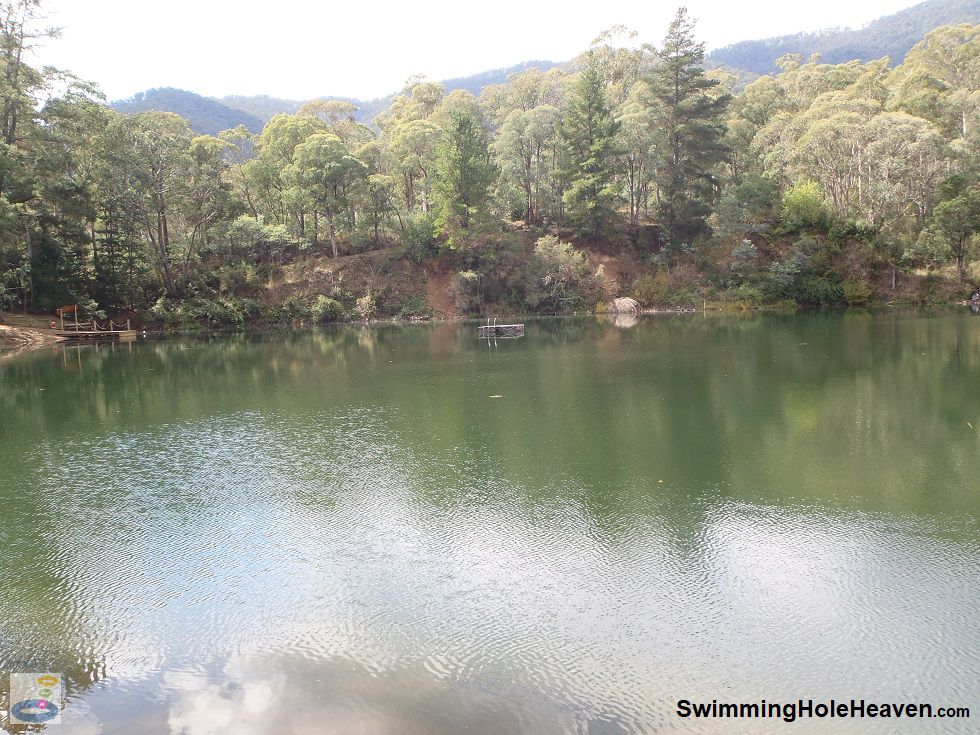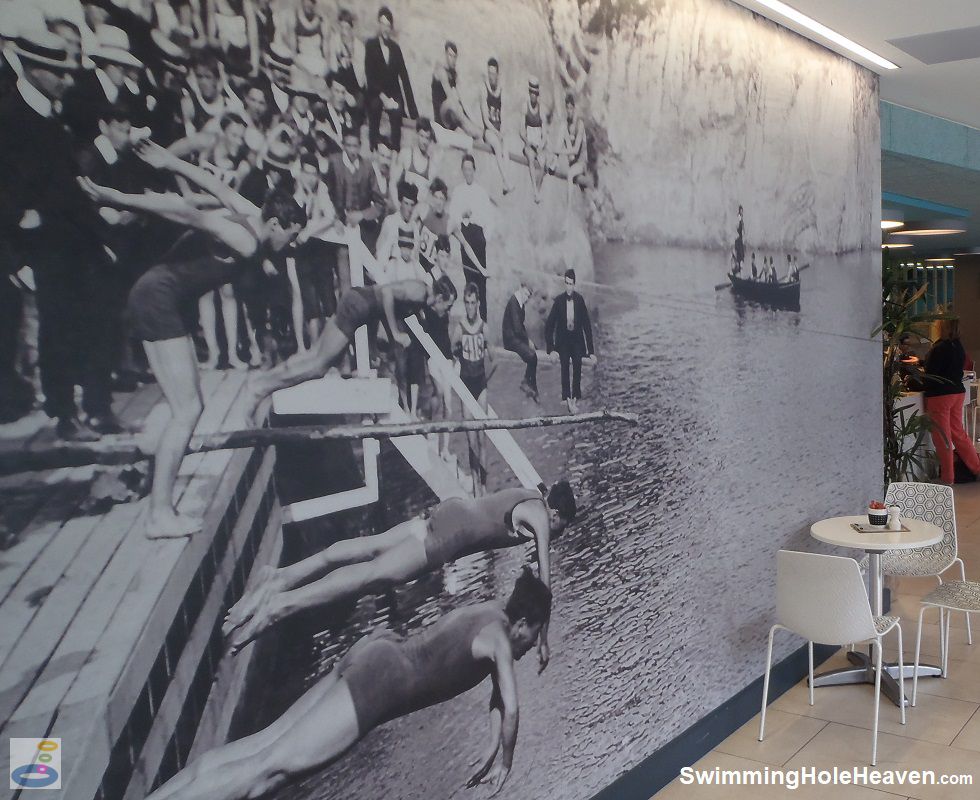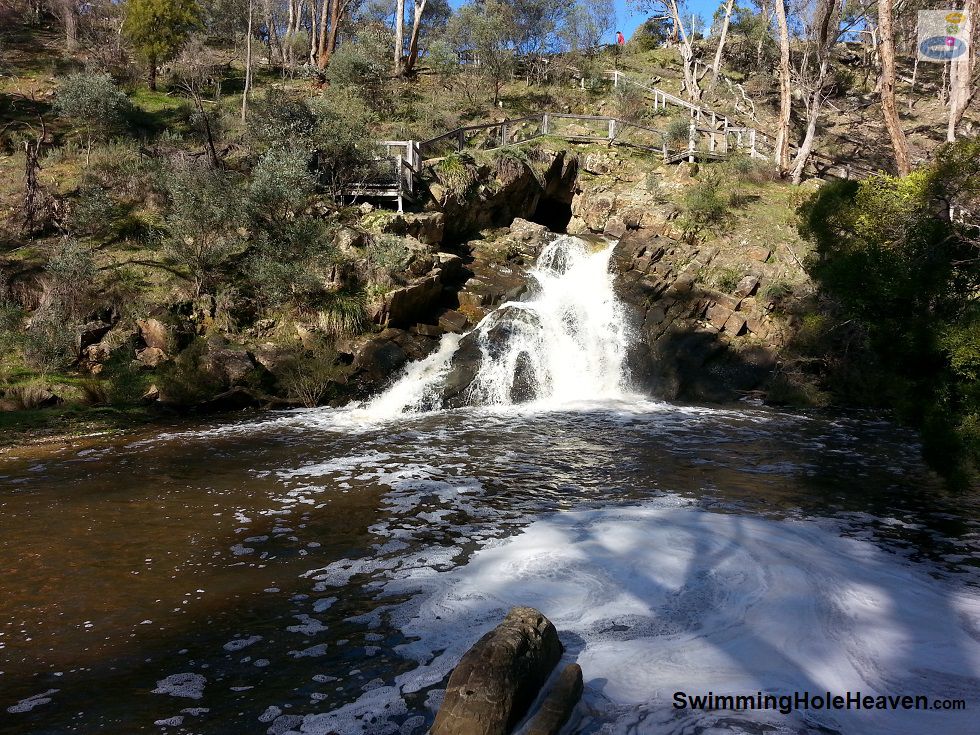| ↑ Swim home | ← Back stroke |
Mining's Swimming Hole LegacySwimming Hole Heaven in Australia
| World Home Page |
| Australia Home |
| VIC Home |
| Regions of Victoria: |
| Melbourne |
| North East Victoria |
| Gippsland |
| Western Victoria |
| Other information: |
| Water Safety |
| Map |
| List of Lists |
| Order the Book |
| Your Support |
Through digging, dredging and blasting, past mining has inadvertantly led to the formation of some of Australia's best swimming holes today. Whilst some
of the unintended consequences of mining have been horrendous for Australia's waterways and landscapes (think Juunkan Gorge, Mt Lyell or Rum Jungle), one
accidental positive legacy has been the creation of the following swimming spots. I have swum at all of the following locations, long after mining had ceased, with the exception
of those now closed to swimming. If you want to know more about each swim, click on the header links.
1. Shaws Lake, Blackwood
This swimming hole is a former water supply dam built over 100 years ago for former gold mining operations. Gold mining can use a lot of water, particularly for sluicing, so Shaws Lake was created by the Shaw Brothers in Blackwood, Victoria to hold water for their gold mining operations. Water was delivered from the dam through a series of water races downstream. According to Blackwood Historian Margot Hitchcock's facebook page the lake was dug by hand. At one time the lake had a diving board, and is now a tranquil swimming spot in the Lerderderg State Forest.
2. Tronoh Dredge Hole, Harrietville
This swimming hole was formed by digging a giant hole on a former bend of the river. Dredging of the upper Ovens River gravel beds for gold was so extensive that the course of the river was changed, with many of the natural bends disconnected from the river and mined, leaving behind dead straight river sections.
One of those former bends is the Tronoh Dredge Hole
at Harrietville, which sits quietly in the forest adjacent to today's river course. This swimming spot is now only partially connected to the main river via a diversion channel designed to
improve water quality in the dredge hole. When the water quality is good, swim out to the floating pontoon in the middle of the lake.
 Above: Tronoh Dredge Hole alongside the Ovens River at Harrietville
(Order this image)
Above: Tronoh Dredge Hole alongside the Ovens River at Harrietville
(Order this image)
3. Nimmo Bridge, Myrtleford
This swimming hole was formed by a dredge that was mining the gravel bed in the Ovens River at Myrtleford. Unfortunately, the dredge got too close to the giant rock bar that spans the river here, hit it and sank. Normally this kind of in-river dredging does not create swimming holes. The gravel bed is mined at the front of the barge, sifted and sorted on the boat to separate out the gold, and then the waste gravel is spat out at the back of the barge to return the gravel to the river bed. However, in this case, because the dredge suddenly stopped working, it left a deep swimming hole at the front of the barge, adjacent to the rock bar. Whilst some of the dredge was recovered, some of it still lies on the bottom of that deep hole.
4. Surrey Dive, Box Hill, Melbourne
This former swimming hole is an example of a quarry that was re-purposed as a swimming venue after its quarrying days were over. Surrey Dive was the home of a local swimming club for several decades and was a popular hangout in the days before municipal pools were built.
The steep walls of the quarry were also popular for cliff jumping into the water from a great height. Today Surrey
Dive is home to a model boat club, with swimmers now heading to the chlorinated indoor pool built next door instead.
 Above: Former brickwork quarry turned swimming hole, Surrey Dive
Above: Former brickwork quarry turned swimming hole, Surrey Dive
5. The Blow Hole, Hepburn Springs
This swimming hole is a shallow pool created downstream of a tunnel that was blasted through a hill of rock. It changed the course of Sailors Creek, which allowed for dry mining of the river bed on the bend upstream that was bypassed by the tunnel. At the Blow Hole, the 75 metre tunnel isolated a 900 metre stretch of river bed from the flow of water. Today when the water is blowing hard through the elevated tunnel, it scours out the river bed below, which has created a small pool for bathing.
 Above: The elevated tunnel to divert the creek at The Blow Hole
(Order this image)
Above: The elevated tunnel to divert the creek at The Blow Hole
(Order this image)
6. Pound Bend, Warrandyte, Melbourne
Dry mining of a river bend was scaled up in this section of the Yarra River, with a several meter diameter tunnel blasted through 180 metres of rock. It temporarily cut off and dried up a 4 km stretch of the Yarra River for gold mining.
The flow of water along the natural course of the river has since been
restored, but water also continues to flow through the tunnel. Today the tunnel outlet is a popular spot for a massage in the current, wedged between the rocks, with
a shallow rock pool for bathing.
There are several more great swimming holes created from former mining activities in my Guide to Freshwater Swimming Holes in Victoria, including one of my favourites up in the Victorian high country.
Before you head out to any of these spots, make sure to read my swimming safety information.
1. Shaws Lake, Blackwood
This swimming hole is a former water supply dam built over 100 years ago for former gold mining operations. Gold mining can use a lot of water, particularly for sluicing, so Shaws Lake was created by the Shaw Brothers in Blackwood, Victoria to hold water for their gold mining operations. Water was delivered from the dam through a series of water races downstream. According to Blackwood Historian Margot Hitchcock's facebook page the lake was dug by hand. At one time the lake had a diving board, and is now a tranquil swimming spot in the Lerderderg State Forest.
2. Tronoh Dredge Hole, Harrietville
This swimming hole was formed by digging a giant hole on a former bend of the river. Dredging of the upper Ovens River gravel beds for gold was so extensive that the course of the river was changed, with many of the natural bends disconnected from the river and mined, leaving behind dead straight river sections.
 Above: Tronoh Dredge Hole alongside the Ovens River at Harrietville
(Order this image)
Above: Tronoh Dredge Hole alongside the Ovens River at Harrietville
(Order this image)
3. Nimmo Bridge, Myrtleford
This swimming hole was formed by a dredge that was mining the gravel bed in the Ovens River at Myrtleford. Unfortunately, the dredge got too close to the giant rock bar that spans the river here, hit it and sank. Normally this kind of in-river dredging does not create swimming holes. The gravel bed is mined at the front of the barge, sifted and sorted on the boat to separate out the gold, and then the waste gravel is spat out at the back of the barge to return the gravel to the river bed. However, in this case, because the dredge suddenly stopped working, it left a deep swimming hole at the front of the barge, adjacent to the rock bar. Whilst some of the dredge was recovered, some of it still lies on the bottom of that deep hole.
4. Surrey Dive, Box Hill, Melbourne
This former swimming hole is an example of a quarry that was re-purposed as a swimming venue after its quarrying days were over. Surrey Dive was the home of a local swimming club for several decades and was a popular hangout in the days before municipal pools were built.
 Above: Former brickwork quarry turned swimming hole, Surrey Dive
Above: Former brickwork quarry turned swimming hole, Surrey Dive
5. The Blow Hole, Hepburn Springs
This swimming hole is a shallow pool created downstream of a tunnel that was blasted through a hill of rock. It changed the course of Sailors Creek, which allowed for dry mining of the river bed on the bend upstream that was bypassed by the tunnel. At the Blow Hole, the 75 metre tunnel isolated a 900 metre stretch of river bed from the flow of water. Today when the water is blowing hard through the elevated tunnel, it scours out the river bed below, which has created a small pool for bathing.
 Above: The elevated tunnel to divert the creek at The Blow Hole
(Order this image)
Above: The elevated tunnel to divert the creek at The Blow Hole
(Order this image)
6. Pound Bend, Warrandyte, Melbourne
Dry mining of a river bend was scaled up in this section of the Yarra River, with a several meter diameter tunnel blasted through 180 metres of rock. It temporarily cut off and dried up a 4 km stretch of the Yarra River for gold mining.
There are several more great swimming holes created from former mining activities in my Guide to Freshwater Swimming Holes in Victoria, including one of my favourites up in the Victorian high country.
Before you head out to any of these spots, make sure to read my swimming safety information.
| ↑ Swim home | ← Back stroke |
| Australia | Victoria |
| Water Safety | Map |
| List of Lists | Suggest a Swim |
| Links | Your Support |
| Media | Order the Book |
|
|
|
|
|
|
|
|
|
|
© Brad Neal 2024. All rights reserved. Swimming Hole Heaven is a registered trademark. Here are my
affiliate links and cookies policy and opportunities to provide support to Swimming Hole Heaven.